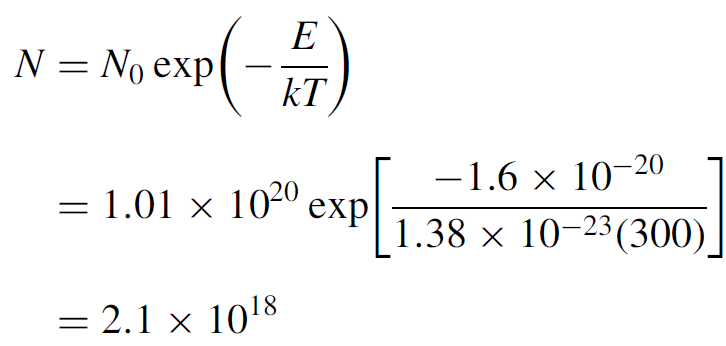


 الفيزياء الكلاسيكية
الفيزياء الكلاسيكية
 الكهربائية والمغناطيسية
الكهربائية والمغناطيسية
 علم البصريات
علم البصريات
 الفيزياء الحديثة
الفيزياء الحديثة
 النظرية النسبية
النظرية النسبية
 الفيزياء النووية
الفيزياء النووية
 فيزياء الحالة الصلبة
فيزياء الحالة الصلبة
 الليزر
الليزر
 علم الفلك
علم الفلك
 المجموعة الشمسية
المجموعة الشمسية
 الطاقة البديلة
الطاقة البديلة
 الفيزياء والعلوم الأخرى
الفيزياء والعلوم الأخرى
 مواضيع عامة في الفيزياء
مواضيع عامة في الفيزياء|
Read More
Date: 20-1-2021
Date: 11-4-2016
Date: 20-3-2016
|
THERMAL POPULATION EFFECTS
As mentioned previously, the effect of thermal energy on the population of energy levels is negligible in most cases. For a helium–neon laser, the lower lasing level is almost 19 eV above ground, so thermal populations are essentially zero at any practical operating temperature. The situation does exist, though, in some laser systems where the lower lasing level is very close to the ground level and thermal effects cannot be ignored. Where two or more transitions are possible, with one having a lower level close to ground state, a transition with a higher lower level may be favored.
Consider a common YAG laser in which neodymium ions are the active lasing species. Examining the energy levels and transitions of this laser, we see that several lasing transitions are possible, yet 1064 nm is the most powerful and the others rarely appear. As expected, each lower level is actually a cluster of levels tightly clumped together. The lower level for the 946-nm transition, for example, is part of a cluster of levels situated below 0.1 eV, referred to as ground state. Indeed, even ground state for an ion may be composed of a number of tightly clumped levels. Unlike the 1064-nm transition, where the lower level is 1.2 eV above ground state and where the population of this level from temperature alone is negligible, the population of the lower level for the 946-nm transition is very much affected by thermal population effects. Note that in a hot YAG rod (i.e., around 1000 K), the thermal effects on the 1064-nm transition can become significant (although in practice a rod would never be allowed to reach so high a temperature).
Example 1.1 Thermal Populations in a YAG Rod Consider a YAG rod doped with a total of 1.01 × 1020 neodymium ions. At a temperature of 300 K, the population of the lower level for the 946-nm transition can be calculated using Boltzmann statistics to be

This means that the upper lasing level for that transition must be filled to at least that quantity in order to have 946-nm emission. Contrast this to the population of the lower level for the 1064-nm transition at the same temperature as that of one (yes, only one) of the 1.01 × 1020 neodymium ions. It is fair to say that thermal effects on the 1064-nm transition’s lower level are negligible, but clearly that is not the case for the 946-nm transition, which has a lower level much closer to ground. All things being equal, we need a much higher pump power to excite the 946-nm transition. Like a three-level laser, this transition requires a large population to be excited to the upper level to ensure an inversion. Despite strong pumping, it is possible in some cases that the maximum number of ions pumped to the upper level for this transition will still be insufficient to ensure an inversion. The option, then, is to cool the rod (e.g., with liquid nitrogen at 77 K) to lower the thermal population of this level and allow a population inversion to occur.
Other systems exist with similar energy levels, such as erbium (Er3+ with a 1.55- μm emission) as used in fiber amplifiers. At a temperature of 300 K the system is essentially a three-level system since the lower lasing level is quite close to the ground state. At a temperature of 77 K (brought on by liquid-nitrogen cooling), the system is a four-level system, and population inversion is much easier to achieve.



|
|
|
|
دراسة يابانية لتقليل مخاطر أمراض المواليد منخفضي الوزن
|
|
|
|
|
|
|
اكتشاف أكبر مرجان في العالم قبالة سواحل جزر سليمان
|
|
|
|
|
|
|
اتحاد كليات الطب الملكية البريطانية يشيد بالمستوى العلمي لطلبة جامعة العميد وبيئتها التعليمية
|
|
|